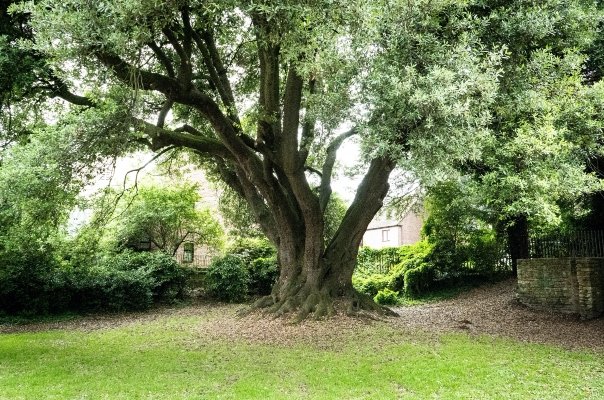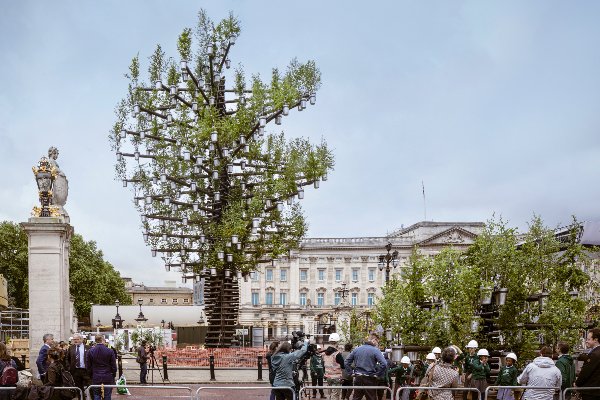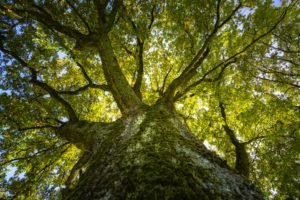‘YouGov polling shows 83% of people in Great Britain support giving ancient trees legally protected heritage status.
‘What’s more, 85% of people think national government and its agencies should have responsibility for protecting them. The stats show just how much these trees mean to people.’
NAOMI TILLEY
Lead campaigner at the Woodland Trust
GORTON PARK POPLAR,
Manchester
Approximate age: Unknown; girth: 4.07 metres
Another rare survivor, this black poplar tree is a reminder of Manchester’s industrial heritage. As manufacturing in the city boomed, soot and air pollutants from coal-burning factories killed many of the city’s trees, but the black poplar was found to thrive despite the conditions.
It was easy enough to grow too and became a familiar sight in the North West in the 20th century – so much so the tree is also known as the Manchester poplar.
But while the species tolerated pollution, disease has sadly proved fatal for most. Over the last 20 years, many black poplars have succumbed and this Gorton Park specimen is one of only a few thousand remaining.
GRANTHAM OAK
Grantham, Lincolnshire
Approximate age: Over 500 years old; girth: 7.02 metres
Towering above a quiet residential street, Grantham’s oldest resident predates the surrounding houses by several centuries. The area has never been parkland, so this tree could be a chance survivor or a lone reminder of the agricultural land that Grantham’s streets now occupy.
To give this ancient oak the care it deserves, the Woodland Trust has worked with the local council and residents to install a protective surface and barrier to keep the tree safe from harm.
In 2023, cuttings were grafted onto rootstock from the Bowthorpe Oak, another local ancient oak. The resulting 23 saplings can be considered descendants of the Grantham Oak and will preserve the hardy genetic traits that have helped it live so long.
CHELSEA ROAD ELM
Sheffield, South Yorkshire
Approximate age: Estimated 128 years old; girth: 2.80 metres
Unknowing passers-by might not give this mature street tree a second glance, but it’s one of the UK’s most famous elms.
Fewer than 1,000 elms still stand after Dutch elm disease sadly wiped out over 60 million of them, but this tree is fortunately resistant. This alone makes it special, but it’s also home to the white-letter hairstreak butterfly, a species that has declined 93% since the 1970s.
It’s been ear-marked for the chop several times, most notably during Sheffield City Council’s 2017 felling programme, but was saved by local campaigners who spied the butterfly laying eggs on the tree.
PLYMOUTH PEAR
Plymouth, Devon
Approximate age: Unknown; girth: 1.30 metres
Derriford’s Plymouth Pear is one of the UK’s rarest trees – the only tree species protected under the Wildlife and Countryside Act 1981.
Though it might once have been widespread in our woodlands, the species is now thought to live exclusively in wild hedgerows in Plymouth and Truro.
Covered with pure white flowers in spring, this particular tree is all the more impressive as much bigger trees in the area have been lost to new roads. A protective barrier now safeguards it for future generations.
SWEET CHESTNUT
Wrexham
Approximate age: 484 years; girth: 6.05 metres
The sweet chestnut of Acton Park has become a reliable fixture in the landscape. It has withstood many challenges during its half-millennium, from post-war plundering of the park for firewood in the 1940s to dozens of deadly storms, including that of 2021 when many neighbouring trees lost limbs or were toppled completely.
Now a feature of community events, the stately tree is well-loved by locals for its history, value and beauty.
HIGHLAND GATEWAY WALNUT
Perth
Approximate age: 250-300 years; girth: 2.34 metres
Standing proud in the car park of Inveralmond Retail Park on the A9, this majestic multi-stemmed tree is a real eye-catcher in the urban landscape.
The area is known as the Highland Gateway and is popular with travellers heading north from Perth towards the Highlands.
Visitors admire this noticeably lovely and unusual tree amid all the concrete and especially appreciate it in summer when its boughs offer shade and relief from the hustle and bustle as well as the sun’s hot rays.
BELVOIR OAK
Belfast
Approximate age: 500+ years old; girth: 8.01 metres
The fascinating fragmented form of this ancient tree makes it difficult to estimate its age with confidence, but it was claimed that the oaks of Belvoir were over 300 years old more than a century ago.
Thought to be the oldest surviving tree in Belvoir Park Forest, it may be the oldest in all of Northern Ireland.
The gnarly survivor is recognised as part of the country’s living heritage, having witnessed the growth of Belfast from a small settlement to the city it is today.
PUBLIC WILDCARD NOMINATION: LIBRARY HOLM OAK
Westbury, Wiltshire
Approximate age: Unknown; girth: 7.10 metres
Chosen from our public nominations, this holm oak watches over the town library from the public Soisy Gardens that wrap around the great building.
Nestled in the hub of the town, the oak’s far-reaching canopy is a popular spot for community events as well as to relax with a borrowed book.
Its history is unknown, but its enormous size suggests it pre-dates the 18th century building, which was originally Westbury House – once home to prominent mill owner and MP, Abraham Laverton.
Don’t forget to cast your vote for 2023’s Tree of the Year – click here to nominate your favourite from the shortlist.
 Play Video about This Rock Might Just Save The World
Play Video about This Rock Might Just Save The World Play Video about Play 2 hours of rock
Play Video about Play 2 hours of rock Play Video about Play 2 hours of brook
Play Video about Play 2 hours of brook Play Video about Play 2 hours of sheep
Play Video about Play 2 hours of sheep















































